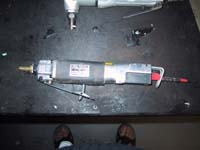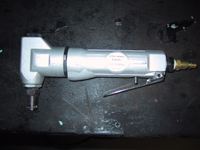Rear Window Seam - Continued:
The seam where the LeBaron�s smaller window insert joins up to the body is now
as clean and free of lead, asbestos rope, and all other fillers as I can get
it. I have used a die-grinder to remove rusted areas at the bottom edge of
the seam and on the bottom edge of the window where water had pooled.
I went to the local steel-supply place in Redwood City, Alan Steel. It�s run
by Alan (I didn�t know that there�d be a guy named Alan at the counter). They
have a gigantic sheet metal cutting machine with a pile of scraps next to it,
and I got a 30� x 60� piece of 22 gauge steel for fixing the rust spots on the
car. There are a few that were under the stainless roof inserts, two almost
identical rot spots at the front edge of the rear wheel well that will be mostly
covered by the stainless trim, and the rotted areas and open channel in the rear
window insert.
I knew that I was going to be working with the steel and trying to form it into
curved shapes. The car is most likely 20 gauge, but I chose 22 so that it would
bend easier, and that worked out really well.
I went shopping at
harbor freight tools for my sheet metal tools. I bought a body saw and a
nibbler.

The body saw (left) is awesome. It�s essentially a small sawz-all that takes a 3-inch
hacksaw blade. At first I didn�t think that I was going to use it when I started
in with the nibbler, but the nibbler is not as precise as this tool. More on that
after I define what the nibbler is.
The nibbler (right) is a really fun tool to operate. I got one that is advertised as more
precise. It gets this by being a punch instead of a scissor-action item. There is
a reciprocating piston-like rod that is thin where it comes out of the tool. Part
way down the rod�s length, the diameter of the rod doubles, with a larger cylinder
forming the lower portion of the rod and a 90-degree flat plane being the
transition. If you got a coffee can, drilled a hole in the metal lid, and put a
broomstick into the hole, you have an idea of the shape, although the tool is
pretty small and fits in your hand. There is a fixed anvil/collar with a
horizontal cut in it that you feed the sheet metal into. When you push the lever
to run the tool, pushing to tool forward, the rod runs up and down through the
 anvil that you are feeding the sheet metal into. The rod goes below the plane
that the sheet metal is on and then the tool moves forward until the metal touches
the smaller diameter of the rod. The rod then starts into its upward stroke, and
the larger diameter cylinder punches out a crescent of metal, much like a
paper-product hole punch. This is all happening repeatedly at high speed, and
hundreds of little metal crescent punched steel slivers are popping out of the
front of the tool.
anvil that you are feeding the sheet metal into. The rod goes below the plane
that the sheet metal is on and then the tool moves forward until the metal touches
the smaller diameter of the rod. The rod then starts into its upward stroke, and
the larger diameter cylinder punches out a crescent of metal, much like a
paper-product hole punch. This is all happening repeatedly at high speed, and
hundreds of little metal crescent punched steel slivers are popping out of the
front of the tool.
The tool thus �nibbles� its way through the steel. It�s not capable of doing
90-degree turns, but comes close and functionally works just like a jigsaw does
in wood. Nibbling is really fun, and using the tool to form the shapes of metal
needed was a blast and really easy to do.

